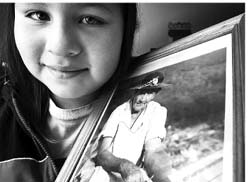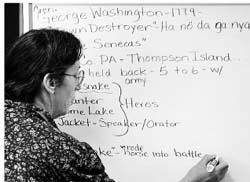|
|
Canku Ota |
|
|
(Many Paths) |
||
|
An Online Newsletter Celebrating Native America |
||
|
June 5, 2004 - Issue 114 |
||
|
|
||
|
Seneca Faithkeepers School Tries to Keep Alive the Tribe's Traditional Ways, Language |
||
|
by Dan Herbeck Buffalo News Staff Reporter |
||
|
credits: photo 1: Lena Pearl Dowdy, named for her great-great grandmother Lena Snow, learns respect for tribal elders at the traditional Seneca school. (photo by Derek Gee/Buffalo News); photo 2: Sandy Dowdy, co-founder of the Faithkeepers School, teaches history from Seneca perspective. (photo by Robert Kirkham/Buffalo News) |
|
In front of a council filled with smoke shop owners and casino enthusiasts, the boy spoke the language of his forefathers, the language of the Longhouse. "This little boy spoke for eight to 10 minutes, all in the Seneca language," said Rickey L. Armstrong Sr., the tribe's president. "I was in awe listening to this." And it all happened because Lehman "Dar" Dowdy doesn't want Seneca tradition to die. "Ninety-nine percent of Senecas don't know how to speak the Seneca language. Everywhere you look, our old ways of life are disappearing," said Dowdy, 65. To counter that loss of heritage, Dowdy and his wife, Sandy, in 1998 started the Seneca Faithkeepers School, where the boy learned to speak the Seneca language. The school is located in the woods of the Allegany Reservation, in a long cedar building modeled after the longhouses, where traditional Senecas hold religious ceremonies. In that building, Seneca children and teenagers spend five days a week learning their nation's language, its history and traditions, from farming techniques to an ancient game played with dice carved from animal bones. Attending the school is a major commitment for young people and their parents. Because the Faithkeepers program is not geared to meet government requirements, each student needs tutoring or home schooling to learn subjects such as math, English and science. Twelve students, ages 8 to 14, now attend the school which, the Dowdys realize, is just a small step toward saving the Senecas' heritage. "I would like to see each of these 12 kids grow up and teach 12 other kids about our language and customs," Dowdy said. "And hopefully, that second group will go on to teach others."
The roles of males and females at the school follow Seneca traditions that aren't always in step with modern America. Only girls are taught to cook. Only boys can play - or even watch - a popular winter sport called "snowsnakes," which involves pushing spears of polished hardwood down a quarter-mile ramp lined with ice. Students maintain the big, bountiful garden behind the school, growing corn, tobacco and scarlet runner beans. One recent afternoon, an elder named Marilyn Cooper taught the girls how to sew colorful "ribbon shirts" that are worn for tribal ceremonies. The children learn about traditional song and dance, self-esteem, the earth's natural energy forces - wind, water, thunder, sun, moon and stars - and the use of plants and bushes to make medicines. "I like the school . . . especially the cultural stuff," said student Robynn George, 13, who first introduced herself by her Seneca name, Gayenesha'a:h. "I like learning about our traditions." Dowdy is a Longhouse faithkeeper who leads many of the ceremonies at the Cold Spring Longhouse on the Allegany Reservation. As a teacher, he gives his lessons a different spin from what the students would hear in public schools. "When I teach them about George Washington, I tell them about the things that George Washington did to our nation," Dowdy said, referring to the army sent to burn and destroy Seneca villages during the Revolutionary War. Students pay nothing to attend the school. Most expenses are covered by donations from Senecas who believe in preserving the nation's old ways. Merle Watt, a wealthy Seneca smoke shop owner, raised much of the money and provided laborers to build the school. The Seneca Nation donated 10 acres for the school, does repairs on the building, provides some tutors and pays Dowdy as a part-time employee. Earlier this month, the nation government donated more than $70,000 to the school after a fund-raiser at the new Seneca Allegany Casino. Armstrong said it would "sicken" him if the nation completely lost touch with its old ways. He said many Seneca elders still recall the days when they learned to speak their own language before English. "I'd like to see a second Faithkeepers School started on the Cattaraugus Territory," Armstrong said. "Anything that Dar Dowdy asks for, I think we should step up to the plate and help him." |
|
|
www.expedia.com |
|
|
||
|
|
||
| Canku Ota is a free Newsletter celebrating Native America, its traditions and accomplishments . We do not provide subscriber or visitor names to anyone. Some articles presented in Canku Ota may contain copyright material. We have received appropriate permissions for republishing any articles. Material appearing here is distributed without profit or monetary gain to those who have expressed an interest. This is in accordance with Title 17 U.S.C. Section 107. | ||
|
Canku Ota is a copyright © 2000, 2001, 2002, 2003, 2004 of Vicki Barry and Paul Barry. |
||
 |
 |
|
|
The "Canku Ota - A Newsletter Celebrating Native America" web site and its design is the |
||
|
Copyright © 1999, 2000, 2001, 2002, 2003, 2004 of Paul C. Barry. |
||
|
All Rights Reserved. |
||
 Last
winter, at a meeting of the Seneca Tribal Council, an 8-year-old
boy stood up to give the invocation.
Last
winter, at a meeting of the Seneca Tribal Council, an 8-year-old
boy stood up to give the invocation. The
school teaches students the ways of the Longhouse religion, as specified
in a spiritual guide called the Gaiwi:yo:h. Pronounced Guy-wee-yo,
the book provides the moral code for Longhouse Senecas.
The
school teaches students the ways of the Longhouse religion, as specified
in a spiritual guide called the Gaiwi:yo:h. Pronounced Guy-wee-yo,
the book provides the moral code for Longhouse Senecas. 